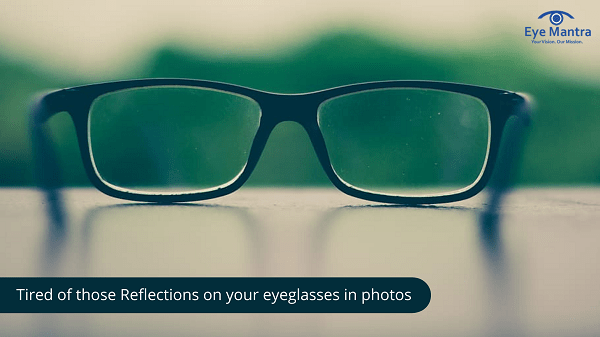The anti-reflective coating is useful in this type of problem which is used in high index lenses, which reflects more light compared to plastic lenses. The higher the index refraction of the lens material, the more light is going to be reflected from the surface of the lenses. Anti-reflective glasses are more attractive, so you’ll look your best altogether lighting conditions. These lenses are consist of multiple layers in which various metals deposited on the surface through vaporization/sublimation. These layers collectively act as a non-reflective surface which lets the incident light undergo the various media almost without loss. This is often an equivalent incident light reflected by the objects enabling us to ascertain them. So, with minimal loss within the quantum of sunshine reaching our eye, the image formed on the retina is far vivid and sharper.
These lenses are also utilized in mountaineering where it helps the user to ascertain through without being subjected to snow blindness, among other such situations. The reflections from the back surface make us uncomfortable. So anti-reflective coating is usually applied to the rear surface in order that we see clearly.
When somebody is watching us by wearing eyeglasses the reflection from the front surface may make our eyes less visible. The front surface coating makes our eye clearly visible to others. Glare depends on other factors as well. Glass has to be properly centered and free of spherical and chromatic aberrations. An Aspheric design reduces spherical aberration. A lens with a higher Abbé number will have less chromatic aberration. High index lenses are thinner and produce less edge glare.
Contents
What is Anti-reflective coating :
The anti-reflective coating is also known as AR, anti-glare, no-glare or glare-free coating. It can provide benefits to your vision. This is added to lenses to reduce glare caused by light hitting the back of the lenses. In the modern invention improves vision and makes your eyeglasses more visually attractive. This helps to eliminate all reflections from the front and back surfaces of your lenses. Without bothersome reflections, more light is able to pass through your lenses which optimizes your vision.
Anti-glare lenses are plane-polarizing lenses which let the sunshine on a single plane to undergo it and stops the sunshine on all other planes from passing. This reduces the glare but enables the attention to possess an entire view.
An anti-reflective or anti-reflection (AR) coating may be a sort of optical coating applied to the surface of lenses and other optical elements to scale back reflection. In typical imaging systems, this improves efficiency since less light is lost.
A common problem with prescription glasses and sunglasses is named back-glare. This is often light that hits the rear of the lenses and bounces into the eyes. The aim of an anti-reflective (AR) coating is to scale back these reflections of the lenses.
How Anti-reflective coating applied:
Earlier, anti-reflective technology has come a long way. It had seemed more like a hindrance than an advantage. There had many problems including a constant need to be cleaned, peeling coating, and frequent scratching. Because of these past problems, many people tend to shy away from them when offered by their opticians. They would rather not have to deal with constant problems with their glasses. However, AR coating has seen several improvements over the past few years and most people think it is worth the extra expense.
The new era of this AR coatings are tough, durable, and provide superior vision. The word “coating” is really a misnomer. This coating is actually fused or “baked” onto the lens matrix, unlike past versions. These coatings also contain chemicals that make them hydrophobic, which means that the lens surface will reduce the adhesion of water and grease. This keeps the lenses cleaner for a longer period of time and makes them much easier to clean when they do become dirty.
Benefits
There are many benefits of this coating which virtually eliminates reflection from the front and back surface of your eyeglass lenses. The reflection goes and more light passes through your lenses to optimize acuity with lesser distraction, and therefore the lenses look almost invisible.
Transparency:
- extremely high transmission — no visible reflection (1%, rather than 8% with float glass)
- reduction of unwanted reflection to supply perfect view through the glass — especially in complex lighting conditions
- high Color Rendering Index for crystal clear transparency
Security:
- perfect view in difficult lighting situations (e.g. during night-time at gas stations, etc.)
Green Building:
- increases natural daylight in rooms and reduces the necessity for artificial lighting.
Quality:
- the best available anti-reflective coating
- easy handling for processors:
- highly scratch-resistant
- easier to wash
- weatherproof for external applications
AR coating benefits include:
- It improves your vision by reducing bothersome reflections, glare, and halos
- Improves night vision
- Makes lenses appear thinner and almost invisible
Related Blogs:
Presbyopia: Causes, Symptoms, and Treatment
Polarized Sunglasses – Working, Advantages, Conclusion
